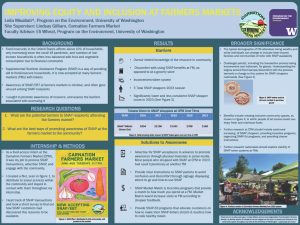EVALUATING A RURAL COMMUNITY’S FOOD ENVIRONMENT: HOW FOOD ACCESS PROGRAMS AT A FARMERS MARKET CAN IMPROVE FOOD EQUITY
Food access programs at farmers markets are a great way to make accessing nutritious foods for people of all income levels easier. Farmers markets provide localized ways of purchasing fresher and more nutritious foods, but the perceived higher cost of food often keeps people in low-income households from attending. The Supplemental Nutrition Assistance Program (SNAP) aids many households that are low-income and food-insecure, and in recent years has been accepted at farmers markets as a resource for SNAP recipients. The purpose of this study was to identify barriers for community members that are food-insecure from attending the Carnation Farmers Market (CFM) in Carnation, WA. To accomplish this task, I monitored how many SNAP transactions were processed at each market, and took a survey on how SNAP shoppers had heard about this resource to see which ways of advertising were most effective. I created a flier to post at social services in the community like food banks, and shelters, and heard back from the managers at these locations to see the engagement with the flier. Findings show that SNAP shoppers at the CFM were most likely to know about the resource from past experiences using SNAP at any farmers market, and through word-of- mouth. SNAP shopper count at each market remained low throughout the season. There are several benefits to attending farmers markets including equity/inclusion, promoting community, and nutrition, but existing barriers including inconvenience and cost continue to inhibit attendance.
